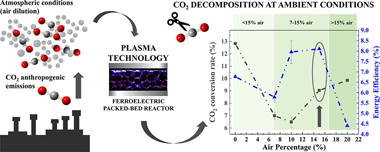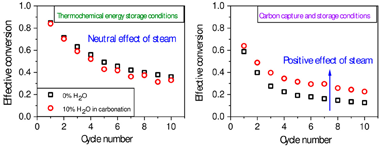Artículos SCI
2022
2022
Nanotecnología en Superficies y Plasma
Plasma assisted CO2 dissociation in pure and gas mixture streams with a ferroelectric packed-bed reactor in ambient conditions
Navascues, P; Cotrino, J; Gonzalez-Elipe, AR; Gomez-Ramirez, AChemical Engineering Journal, 430 (2022) 133066
Show abstract ▽

Carbon dioxide decomposition is a challenging target to combat climate change. Nonthermal plasmas are advantageous for this purpose because they operate at ambient conditions and can be easily scaled-up. In this study, we attempt the CO2 splitting into CO and O-2 in a parallel plate packed-bed plasma reactor moderated with Lead Zirconate Titanate (PZT) as fermelectric component, achieving conversion rates and energy efficiencies higher than those obtained with BaTiO3 in our experimental device. The analysis of the reaction mechanisms with optical emission spectroscopy under various operating conditions has shown a direct correlation between energy efficiency and intensity of CO* emission bands. These results and those obtained with a LiNbO3 plate placed onto the active electrode suggest that high temperature electrons contribute to the splitting of CO2 through an enhancement in the formation of CO2+ intermediate species. Results obtained for CO2 + O-2 mixtures confirm this view and suggest that back recombination processes involving CO and O-2 may reduce the overall splitting efficiency. The study of mixtures of CO2 and dry air has proved the capacity of fermelectric packed-bed reactors to efficiently decompose CO2 with no formation of harmful NxOy subproducts in conditions close to those in real facilities. The found enhancement in energy efficiency with respect to that found for the pure gas decomposition supports that new reaction pathways involving nitrogen molecules are contributing to the dissociation reaction. We conclude that PZT moderated packed-bed plasma reactors is an optimum alternative for the decompositon of CO2 in real gas flows and ambient conditions.
Febrero, 2022 | DOI: 10.1016/j.cej.2021.133066
Reactividad de Sólidos
Flash Sintering Research Perspective: A Bibliometric Analysis
Gil-Gonzalez, E; Perez-Maqueda, LA; Sanchez-Jimenez, PE; Perejon, AMaterials, 15 (2022) 416
Show abstract ▽
Flash Sintering (FS), a relatively new Field-Assisted Sintering Technique (FAST) for ceramic processing, was proposed for the first time in 2010 by Prof. Rishi Raj's group from the University of Colorado at Boulder. It quickly grabbed the attention of the scientific community and since then, the field has rapidly evolved, constituting a true milestone in materials processing with the number of publications growing year by year. Moreover, nowadays, there is already a scientific community devoted to FS. In this work, a general picture of the scientific landscape of FS is drawn by bibliometric analysis. The target sources, the most relevant documents, hot and trending topics as well as the social networking of FS are unveiled. A separate bibliometric analysis is also provided for Reaction or Reactive Flash Sintering (RFS), where not only the sintering, but also the synthesis is merged into a single step. To the best of our knowledge, this is the first study of this nature carried out in this field of research and it can constitute a useful tool for researchers to be quickly updated with FS as well as to strategize future research and publishing approaches.
Enero, 2022 | DOI: 10.3390/ma15020416
Materiales Ópticos Multifuncionales
Molecular Interface Engineering via Triazatruxene-Based Moieties/NiOx as Hole-Selective Bilayers in Perovskite Solar Cells for Reliability
Hemasiri, NH; Calio, L; Pegu, M; Kazim, S; Ahmad, SSolar RRL (2022) 2100793
Show abstract ▽
Interface engineering is an effective approach to decrease nonradiative recombination and the energy barrier at the perovskite/hole transporting layer (HTL) interfaces. To overcome such limitations, an organic semiconductor (DTT-EHDI2) is proposed, which is, composed of dithienothiophene (DTT) as the core and a planar triazatruxene incorporating an alkyl chain as the side group. This is noted to be an effective interfacial layer for inverted planar perovskite solar cells (PSCs). The altered interface effectively minimizes the detrimental charge recombination and tailors the photoinduced charge transfer dynamics at the interface of the inorganic HTL/perovskite. The pi-conjugation in DTT-EHDI2 induces high hole mobility and electrical conductivity via electron-donating properties and strong pi-pi intermolecular interaction. The synergetic approach leads to a substantial performance enhancement in dopant-free DTT-EHDI2-based inverted planar PSCs, achieving 18.15% power conversion efficiency with negligible hysteresis effect. The present approach provides an effective direction of the cost-effective thiophene derivative as an interfacial agent to escalate the optoelectronic performances in photovoltaics.
Enero, 2022 | DOI: 10.1002/solr.202100793
Nanotecnología en Superficies y Plasma
Coarse-grained approach to amorphous and anisotropic materials in kinetic Monte Carlo thin-film growth simulations: A case study of TiO2 and ZnO by plasma-enhanced chemical vapor deposition
Budagosky, J; Garcia-Casas, X; Sanchez-Valencia, JR; Barranco, A; Borras, APlasma Processes and Polymers (2022) e2100179
Show abstract ▽
The growth of TiO2 and ZnO thin films is studied by means of coarse-grained kinetic Monte Carlo simulations under conditions typically encountered in plasma-enhanced chemical vapor deposition experiments. The basis of our approach is known to work well to simulate the growth of amorphous materials using cubic grids and is extended here to reproduce not only the morphological characteristics and scaling properties of amorphous TiO2 but also the growth of polycrystalline ZnO with a good approximation, including the evolution of the film texture during growth and its dependence on experimental conditions. The results of the simulations have been compared with available experimental data obtained by X-ray diffraction, analysis of the texture coefficients, atomic force microscopy, and scanning electron microscopy.
Enero, 2022 | DOI: 10.1002/ppap.202100179
Reactividad de Sólidos
Effect of Steam Injection during Carbonation on the Multicyclic Performance of Limestone (CaCO3) under Different Calcium Looping Conditions: A Comparative Study
Troya, JJA; Moreno, V; Sánchez-Jiménez, PE; Perejon, A; Valverde, JM; Perez-Maqueda, LAACS Sustanaible Chemistry & Engineering, 10 (2022) 850-859
Show abstract ▽

This study explores the effect of steam addition during carbonation on the multicyclic performance of limestone under calcium looping conditions compatible with (i) CO2 capture from postcombustion gases (CCS) and with (ii) thermochemical energy storage (TCES). Steam injection has been proposed to improve the CO2 uptake capacity of CaO-based sorbents when the calcination and carbonation loops are carried out in CCS conditions: at moderate carbonation temperatures (similar to 650 degrees C) under low CO2 concentration (typically similar to 15% at atmospheric pressure). However, the recent proposal of calcium-looping as a TCES system for integration into concentrated solar power (CSP) plants has aroused interest in higher carbonation temperatures (similar to 800-850 degrees C) in pure CO2. Here, we show that steam benefits the multicyclic behavior in the milder conditions required for CCS. However, at the more aggressive conditions required in TCES, steam essentially has a neutral net effect as the CO2 uptake promoted by the reduced CO2 partial pressure but also is offset by the substantial steam-promoted mineralization in the high temperature range. Finally, we also demonstrate that the carbonation rate depends exclusively on the partial pressure of CO2, regardless of the diluting gas employed.
Enero, 2022 | DOI: 10.1021/acssuschemeng.1c06314
- ‹ anterior
- 58 of 410
- siguiente ›














